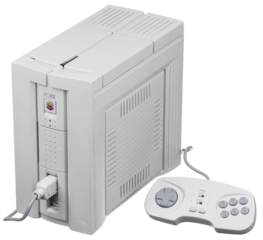Difference between revisions of "PC-FX"
From NEC Retro
| Line 17: | Line 17: | ||
The PC-FX stands as a curious mid-point between traditional early-90s video game consoles and desktop computers (of which NEC already had a healthy stake in with the [[PC-9800 series]] line). It resembles a typical upright (albeit smaller) mid-90s PC, however is designed to play video games shipped on CD-ROMs with a traditional, six-button controller - the [[FX-Pad]]. | The PC-FX stands as a curious mid-point between traditional early-90s video game consoles and desktop computers (of which NEC already had a healthy stake in with the [[PC-9800 series]] line). It resembles a typical upright (albeit smaller) mid-90s PC, however is designed to play video games shipped on CD-ROMs with a traditional, six-button controller - the [[FX-Pad]]. | ||
| − | The CD drive is located on the top of the unit (a design also witnessed in the [[PC- | + | The CD drive is located on the top of the unit (a design also witnessed in the [[PC-8801 MC]]), and the console is designed to be expandable. No keyboard was ever manufactured for the PC-FX, meaning it was never suited to traditional office software such as word processing, but a mouse was created in the form of the [[FX-Mou]], primarily used for strategy games. |
===Technical Specifications=== | ===Technical Specifications=== | ||
Revision as of 05:24, 10 October 2015

| ||||||||||
| PC-FX | ||||||||||
|---|---|---|---|---|---|---|---|---|---|---|
| Manufacturer: NEC | ||||||||||
|
This short article is in need of work. You can help NEC Retro by adding to it.
The PC-FX (ピーシー エフエックス) is a video game console created by NEC as a successor to the PC Engine and its many add-ons and derivatives. After a protracted development timeline, it was released in Japan in December 1994.
Hardware
The PC-FX stands as a curious mid-point between traditional early-90s video game consoles and desktop computers (of which NEC already had a healthy stake in with the PC-9800 series line). It resembles a typical upright (albeit smaller) mid-90s PC, however is designed to play video games shipped on CD-ROMs with a traditional, six-button controller - the FX-Pad.
The CD drive is located on the top of the unit (a design also witnessed in the PC-8801 MC), and the console is designed to be expandable. No keyboard was ever manufactured for the PC-FX, meaning it was never suited to traditional office software such as word processing, but a mouse was created in the form of the FX-Mou, primarily used for strategy games.
Technical Specifications
History
Development
Release
Legacy
The PC-FX was considered by the Japanese public to be an expensive and underpowered system. Its lack of native 3D capabilities put it at a disadvantage against the Sega Saturn and Sony's PlayStation which had debuted in the same holiday season, and the console was largely shunned by third-party developers as a result. Only a hundred thousand units were produced as opposed to the millions of PC Engines, and the system did not leave Japan in any form, with even NEC citing price as a concern in Western markets.
In early 1998 the console was discontinued, and NEC effectively left the home console business.